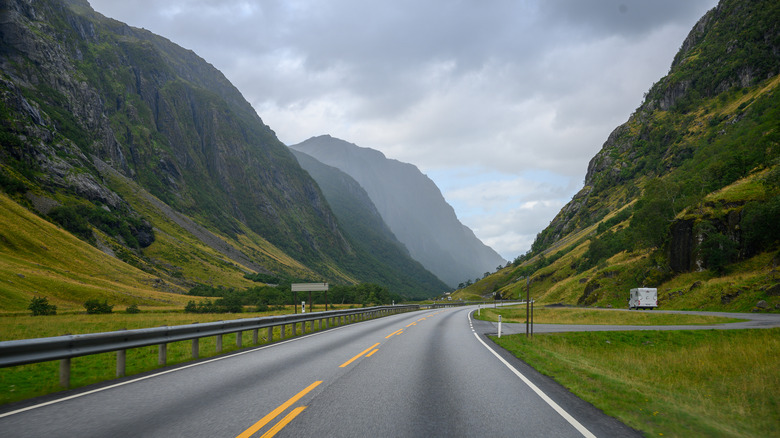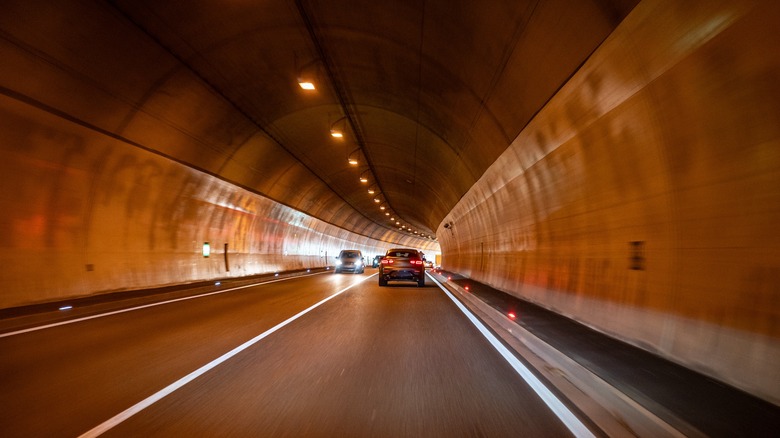This Is The World's Deepest Underwater Tunnel You'll Be Able To Drive Through (Eventually)
Traveling Norway's E39 highway is often an unforgettable, but arduous adventure. The route, which spans nearly 1,100 kilometers (683 miles), is an engineering marvel, and has been constructed in a region known for its challenging terrain. The entire trip involves multiple ferry crossings and tunnels, through the challenging fjords of Norway. It's no surprise, therefore, to see the total travel time via the E39 exceeding 21 hours.
For years, Norway has envisioned a project that would make travel on the E39 easier. It eventually came up with the "E39 Ferry Free plan" which would replace the current seven ferry crossings on the E39 highway with bridges and tunnels. Once complete, the route will be 50 kilometers shorter, with travel times reducing significantly. One of the most important parts of his project is a new subsea road tunnel called the Rogfast. Also known as the Rogaland fixed link, once complete, it will become the world's longest and deepest subsea road tunnel.
This massive tunnel project will stretch 26.7 kilometers (about 16.5 miles) and reach a depth of nearly 390 meters (around 1,300 feet) below sea level. It will run under the fjords between Randaberg and Bokn on Norway's rugged west coast. At present, Norway already holds the record for the world's longest road tunnel — the Lærdal Tunnel, which is 24.5 kilometers long, but that one runs through mountains, not under the ocean. But what has really prompted Norway to go ahead with the Rogfast project is its past success with the Ryfylke tunnel, which holds the current record for the longest undersea road tunnel in the world at 14.3 kilometers (8.8 miles).
The Rogfast tunnel: key facts
Norway's engineers will build Rogfast using a "drill and blast" method to tunnel through hard rock beneath the seabed. This approach is common in Norway, which has built dozens of subsea tunnels already. Unlike other major underwater tunnels, such as the Channel Tunnel between the U.K. and France (which made it into our list of world class attractions), or Denmark's upcoming Fehmarn Belt link, Rogfast won't use giant pre-made sections sunk into a trench. Instead, it will be carved directly through solid rock.
The tunnel's deepest section will lie about 50 meters below the sea floor to keep the weight and pressure of the sea from pressing directly on its roof. There will be two tubes, each carrying two lanes of traffic. There will be cross passages every few hundred meters connecting the two tunes, providing emergency exits and maintenance access. Under the island of Kvitsøy, the tunnels will also get an underground roundabout for travelers wishing to take an exit to Kvitsøy. Lighting, air ventilation, cameras, and fire-safety systems will all be built in. Work on Rogfast started back in 2018, and crews have made steady progress.
Building a tunnel this big isn't cheap — and the Rogfast tunnel is expected to cost about 25 billion Norwegian kroner, which translates to roughly $2.49 billion. But for a country with more than 40 subsea tunnels already in use, it's seen as a logical next step.
How soon can you drive through the Rogfast?
When Norway originally envisioned the project and began construction, the plan was to complete it by 2025. However, as expected of a project of this scale and complexity, it encountered several political controversies and cost overruns. As of 2025, construction is still underway in full swing. The revised completion schedule, however, has been extended to 2033.
As outlined earlier, the tunnel is one piece of a wider plan to replace many of the ferries that still connect sections of Norway's long E39 coastal highway. Because of the country's deep fjords and steep terrain, roads have always been broken up by stretches of water that required ferries. When complete, Rogfast will help close one of the largest gaps.
After completion, around 13,000 vehicles a day are expected to use it by 2053. For the region, the new tunnel means faster transport for goods, easier commutes, and new opportunities for tourism in parts of the country that used to be harder to reach by car. As for the rest of the E39 ferry free project, Norway is also studying other advanced ideas, like submerged floating tunnels for parts of the E39 where the fjords are too deep for drilling. The country is also working in the equally complex Stad Ship Tunnel project that was proposed several years ago.


